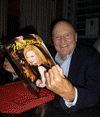 |
This is an odd time of the movie year: Two blockbusters have already opened. Van Helsing (starring Hugh Jackman), which will soon surpass the $100 million mark, is an incredibly effective, thrilling homage to the great horror movies produced at Universal Studios back in the 40s and 50s. It was followed by Troy (Warner Bros.), which arrived a week later, with Brad Pitt in the lavish retelling of the Greek-Trojan War, circa 1100 B.C., give or take a few years; check your Homer.
The studios have yet to unleash the full brunt of the summer avalanche of blockbusters and sequels, with the exception of Shrek 2 (DreamWorks), yet to be seen/reviewed by this critic at press time. So what to do? During this “in between” lull, seek out an amazing Argentine movie called Valentin (Miramax). It stars an adorable young actor named Rodrigo Noya in a story set in Buenos Aires in 1969. The eight-year-old character longs to be an astronaut, as he tells us in the poignant narration, perhaps as an escape from his humdrum life. He knows the first moon landing is imminent. Because his parents are separated, he lives with his aged, stern, and infirm grandmother, portrayed by the wonderful Spanish actress Carmen Maura. The boy dreams of reuniting his parents (or even finding new ones). When his attempts to reunite his parents fail, he takes matters into his own hands. The film also features Julieta Cardinali who, despite her Italian-sounding name, is an enchanting Argentine actress. She portrays “Letitia,” a former girlfriend of his father, who develops a special relationship with the boy. Touching narration by the young actor helps make Valentin a strong contender for one of the year’s best movies. It conveys tenderness as few films have.
Meanwhile, two superb documentaries are also worth seeing. Super Size Me (Samuel Goldwyn Films) was written, directed, and produced by Morgan Spurlock, a healthy, 6-ft.-2, 185-lb. young man who took his life in his hands by eating three square meals a day for a month in 20 cities … at McDonald’s! He had to accept a “super-size” meal if it was offered; appropriately, that happened most frequently in Texas. Spurlock also vowed to eat everything on the menu at least once. All the while, he kept checking his cholesterol, weight, and vital organs with his internist, cardiologist, and nutritionist. To no one’s surprise, a few weeks of steady junk food caused him to get sick to his stomach; gain 25 pounds; see his cholesterol and blood pressure rise and his energy level and libido drop; suffer bad skin, headaches, and chest pains; and hear that his liver was showing symptoms of toxic shock! Spurlock’s doctors compared his symptoms to those of binge drinking.
This wasn’t a mere stunt. For instance, he takes his cameras to a high school kitchen and interviews “cooks,” who merely distribute government-supplied boxes containing ready-to-serve meals. Spurlock discovered that the meals contain 1,000 calories and provide little nutrition, and it’s no surprise that we see obese students waiting on line for their turn at the trough. Super Size Me is a sobering, chilling condemnation of too many Americans’ eating habits and a fascinating look at our national obsession.
The other wonderful documentary is called Broadway: The Golden Age, by the Legends Who Were There, an astonishingly detailed look at Broadway’s past 60 years, including interviews with some 100 stars — from Carol Channing to the late Hume Cronyn, from Alec Baldwin to the late Gwen Verdon and Bob Fosse. Writer/director/producer/cinematographer Rick McKay begins his journey in his youth in tiny Beech Grove, Indiana, a star-struck, New York-bound acting hopeful. His interviews are perceptive and revealing. The stars recall their struggling days, scratching for jobs and hoping for auditions, sharing apartments and sometimes dresses, hoping to impress producers.
Jerry Orbach recalls looking in The New York Times circa 1949 and thinking how amazing it was that Mr. Roberts, South Pacific, and A Streetcar Named Desire were all playing, in their original productions, at the same time! He recalls watching Member of the Wedding, with Julie Harris, and how it inspired him. Miss Harris, surely Broadway’s greatest living star, also recalls that memorable play, and how it affected her forever.
You also get the sense of uncertainty in out-of-town tryouts, and hear stars confess to their “second-acting” of the day, slipping into theaters after the intermission, pretending to be ticket holders. It was a tradition among hungry acting hopefuls back then.
With the help of Angela Lansbury, Carol Burnett, Robert Goulet, Charles Nelson Reilly, Shirley MacLaine, John Raitt, Kaye Ballard, Jerry Herman, and Charles Durning, to name a few, and rare footage of never-before-seen moments of Broadway classics, McKay con-veys the excitement of an era when some 50 shows (like Oklahoma, My Fair Lady, and Mame) glowed on Broadway. It is a brilliant record of a magical time. We see an incredible video recording of Robert Goulet’s audition for Camelot, home movies of Ann Miller dancing on stage in 1939, and Marlon Brando at the start of his career. Scenes of Times Square 60 years ago — in color! — are nothing short of astonishing.
I do wish there’d been more about Helen Hayes, “The First Lady of the American Theater,” and my favorite Broadway star, Ethel Merman, but sections with Laurette Taylor and Kim Stanley are outstanding.
“I may have been too late to talk with Ethel Merman and Mary Martin,” McKay tells us, “and the only Barrymore left was Drew, but I was determined to find out if Broadway back then was a Golden Era.” It was. Oh, it was! As Dame Dianna Rigg says at the beginning: “The theater is a miracle.” So is this movie.
If you must see a blockbuster now, try Van Helsing, with great special effects and a sense of humor amid the mayhem, or Troy, with its heroes and epic battle scenes. Then it’s on to the summer blockbusters!
Jeffrey Lyons has been a film critic since 1970 and has reviewed nearly 15,000 movies and 3,000 plays. The son of Broadway columnist Leonard Lyons, whose “The Lyons Den” was the most respected column of its day (1934-1974), he is the critic at WNBC-TV, and is seen on 200 NBC stations. His “Lyons Den” radio reports are heard on more than 100 stations nationwide.
|




